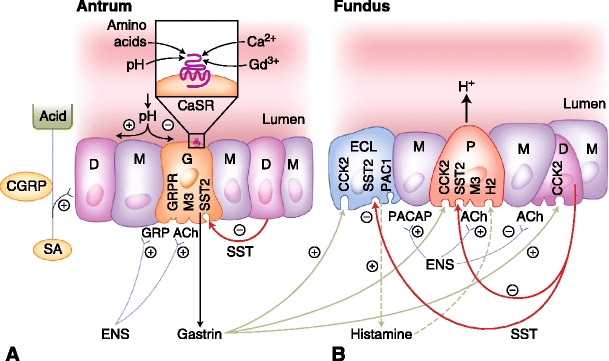Fig. 1.

Hormonal and paracrine signaling regulating gastric acid with respective receptors. Antral gastric glands (A) contain G cells (G), mucous cells (M), and open type D cells (D). Fundic oxyntic glands (B) contain enterochromaffin-like cells (ECL), mucous cells (M), parietal cells (P), and closed-type D cells. The neuronal circuits from the enteric nervous system (ENS) with acetylcholine (Ach) release and selected neuropeptide output are also shown. Feedback control of acid secretion by extrinsic sensory afferent nerves (SA) of nodose and dorsal root ganglion origin includes calcitonin gene-related peptide (CGRP)–related somatostatin release, which indirectly decreases gastrin release (shown in A). The SA nerves monitor luminal acidity, decreasing acid output as pH decreases below 2.5 with reciprocal effects as pH increases. The calcium-sensing receptor (CaSR) depicted on the luminal surface of a G cell is in the family C of G-protein coupled 7 transmembrane receptors (A inset). Agonists include calcium and polyvalent cations such as gadolinium with activity modulated allosterically by L-amino acids and luminal pH. CCK2 cholecystokinin receptor 2; GRP gastrin-releasing peptide; GRPR GRP receptor; H 2 histamine receptor type 2; M3 muscarinic receptor type 3; PACAP pituitary adenylate cyclase-activating polypeptide; PAC1 PACAP receptor type 1; SST somatostatin; SST2 SST receptor type 2; (+) stimulating action; (−) inhibitory action. (Adapted from Wank [10].)
